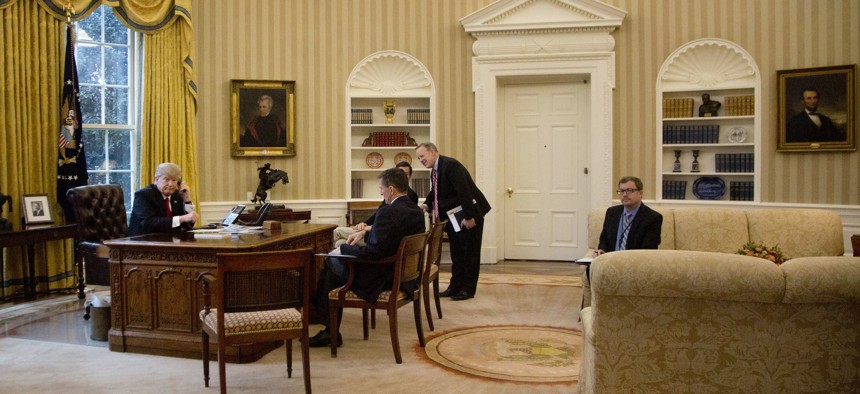
President Donald Trump, left, and National Security Adviser Michael Flynn, second from left, press secretary Sean Spicer, right, and Senior Advisor to the President Jared Kushner, speaks on the phone with Saudi Arabia's King Salman, Jan. 29, 2017. Manuel Balce Ceneta/AP
15 Questions Trump Should Answer About His 'Safe Zones'
If the president is serious about this, White House officials must clarify exactly what this new and expansive military mission would entail.
Yesterday, the White House released the readout of a call between President Donald Trump and the King of Saudi Arabia, Salman bin Abdulaziz al Saud. The statement featured this remarkable statement: “The President requested and the King agreed to support safe zones in Syria and Yemen, as well as supporting other ideas to help the many refugees who are displaced by the ongoing conflicts.”
During the presidential campaign, Trump, as well as Mike Pence, repeatedly endorsed the creation of safe zones in Syria, without adding any clarification. Trump proclaimed that unnamed Middle East countries would pay for the “big, beautiful safe zone” in Syria, while Pence during the vice presidential debate proclaimed they would “create a route for safe passage” and “protect people in those areas, including with the no-fly zone.” Five days later, when asked about his running mate’s position Trump declared flatly: “He and I haven’t spoken, and I disagree.”
Political campaigns are consequence-free environments, but statements made while serving as chief of state should reflect actual government policy. If President Trump is now serious about authorizing the U.S. armed forces to implement safe zones (as indicated by his request to the Saudi monarch), he and his senior aides must clarify exactly what he means by this new, expansive, and poorly conceived military mission.
See also: Make No Mistake: A Syrian Safe Zone is a Major Intervention
And The History of No-Fly Zones Doesn’t Bode Well for Syria
I have written about no-fly zones and safe zones for more than fifteen years. But rather than re-package previous analysis, here are fifteen questions that Congress, journalists, and citizens should expect the Trump administration to answer:
- What is the ultimate political objective of the safe zones? For example, will they provide temporary humanitarian refuge for internally displaced persons, or leverage for a brokered peace agreement?
- What is the domestic legal basis for them?
- As the sovereign government of Syria will presumably oppose them, what is the international legal basis?
- Where exactly within Syria or Yemen will they be located, and why were those locations chosen?
- Will non-combatants as well as rebel groups residing within the safe zones be protected? If not, how will residents be vetted, and who will do the vetting?
- Will those residing within safe zones be protected from all forms of harm, including aerial bombing, artillery shelling, small arms fire, sniper fire, starvation, and lack of clean drinking water and sanitation?
- Will those residing within safe zones be protected from harm by all perpetrators (including by Russian fighter-bombers and U.S.-backed rebel groups in Syria, or by indiscriminate Saudi airstrikes in Yemen)?
- Which countries will provide the military forces for the many tasks required to enforce the safe zones (suppression of enemy air defenses, logistical support, combat search and rescue, etc.)?
- Which groups or states will provide humanitarian assistance and be allowed access to those residing in the safe zones?
- Critically, who provides the ground forces to enforce and patrol the safe zones?
- Which nearby countries will allow safe zone forces basing and overflight rights, and for which missions specifically?
- Who has ultimate command authority for however many countries contribute forces?
- What military doctrine and rules of engagement will guide those forces enforcing the safe zones?
- Will force be used to prohibit arms groups from using the safe zones to shield their activities or recruit fighters, as they inevitably will try to do?
- Who pays, and for how long?
This post appears courtesy of CFR.org.